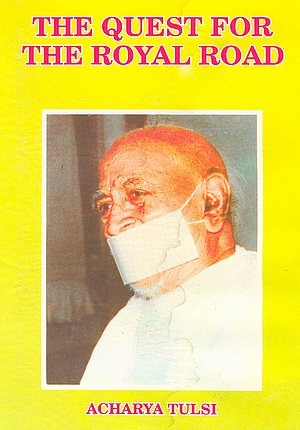Jainism is a very ancient and scientific, that is, a realistic religion. There have been two main trends among the Indian religions-Vedic and shramana. Jainism is the religion belonging to the shramana tradition. It has been described variously as Arhat, Nirgranth, etc. Upto the time of the eighth Acharya after Bhagwan Mahavira, it was known as the Nirgrantha religion. Then it became popular as Jainism. Several centuries after Bhagwan Mahavira's Nirvana, Jainism was divided into two main sects called Digambara and Shvetambara. During the long passage of time, these two sects got further divided into sub-sects. The Therapanth was started by Acharya Bhikshu in the Vikram Era 1817.
Jainism has flourished through the teachings of 24 Tirthankaras. Its prevailing form is what was promulgated by Bhagwan Mahavira, although it has now innumerable sects, with different tradition and practices. Still, there is unity in their basic philosophy. Bhagwan Mahavira's non- absolutistic approach and the resultant philosophy of harmony have a remarkable capacity to bring about harmony. The great thinkers of India today desire that the non-absolutistic approach should be spread to the maximum extent in the world. That would help in solving a large number of problems of the world.
Acharya Bhikshu saw Truth in the wide context and freed religion from its narrow sectarism limits. Through Acharya Bhikshu, the spirit of Bhagwan Mahavira's religion has been very powerfully brought out. The Acharyas who followed him carried his idea forward. In the present age, I got one more chance of developing it further. It makes me happy to think that today the Terapanth Dharma Sangh fairly represents Bhagwan Mahavira's vision of harmony. Respected Jayacharya started the literary trend. Respected Kalugani sowed the seeds of modern disciplines. I had the good fortune of developing it further so that it could flourish and bear fruits. Today, in our Dharma Sangh, there is the confluence of the ancient and the modern disciplines.
The Anuvrat campaign started on the second day of the bright fortnight of the month of Phalgun, 2005 Vikrami Samvat. With that the practical religious formula was presented to the people.
1. I undertook long padyatras alongwith the volunteers of the Dharma Sangh to explain broad view point of religion. From Punjab to Kanyakumari, we travelled about 40,000 miles. The people whole-heartedly accepted the broad viewpoint of religion. We got this liberal, broadminded and harmonious viewpoint from Jainism, from the philosophy of Bhagwan Mahavira.
2. We now have before us another great event. On the Deepavali day in 1974 we will be celebrating the 2500th centenary of Bhagwan Mahavira's nirvana. The Government of India has formed a national committee, representing all the four sects of Jainism- Digambara, Murtipujakas, Sthanakvasis and the Terapanth.
The Jain community is organising a large number of activities in connection with this celebration of Bhagwan Mahavira's nirvana. The Jain Vishva Bharati is being established by our Dharma Sangh. It is proposed to revive the Jain way of sadhana and the Jain yoga alongwith research in the Jain teachings and the basic tenets of Jainism. In the field of religion, new experiments in spiritual and yogic practice are being tried all over the world. Our Dharma Sangh is also moving with the present-day world in this direction. The Jain Vishva Bharati would be the great centre of these activities. The Dharma Sangh as a whole is concentrating its efforts to develop it in the best possible manner.
The idea establishing the Jain Vishva Bharati had been mooted on the 9th day of the dark fortnight of the month of Chaitra, Vikrami Samvat 2028. On that day, I had given the first lesson in Jainism to the ladies of the Transcendental Education Centre. That centre is progressing at its own pace.
In the concrete form, the Jain Vishva Bharati is coming into being today, on the 5th day of the dark fortnight of Phalgun, Vikrami Samvat 2029. The sadhus have been concentrating on building up this great institution at the subtle level, while sravakas are working devotedly to build utj its physical structure. With that, this institution appears to have a bright future. Its future would be a reflection of Jainism in the coming age. The whole world would find through the light of knowledge, harmony, sadhana and peace.
It was said in the days of Bhagwan Mahavira. Many people have become siddhas on account of religion, they are continuing to and would continue to be siddhas.[1]
In the present age it would be said that many people have become, are becoming and would become sadhakas on account of the Jain Vishva Bharati. My good wishes for that learning and that sadhana.
1. Society has moved in a new direction because of anuvrat, it has broken traditions and marched ahead.
2. In the field of literature, our Dharma Sangh has progressed well. The literature published by the Sangh has good impact in many directions.
The work of compiling thecomas has been going on for the last two decades. In a way, the original texts of the Agamas are being prepared on a large scale after Devardhigani. It would be a great tribute to Bhagwan Mahavira from the Terapanth.
 Acharya Tulsi
Acharya Tulsi
